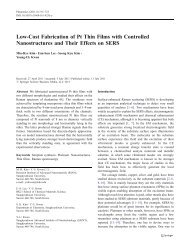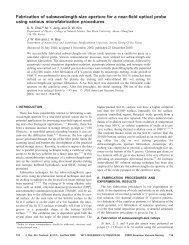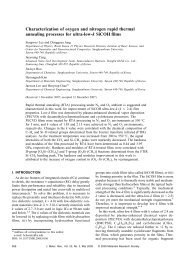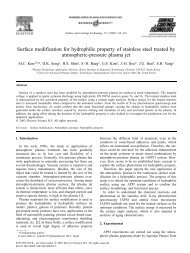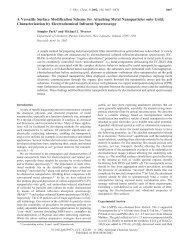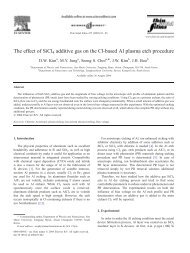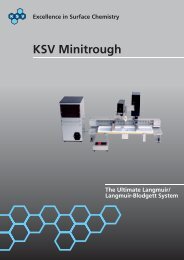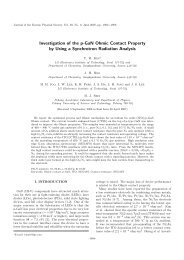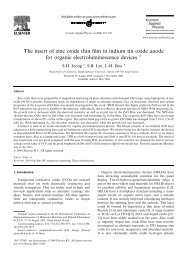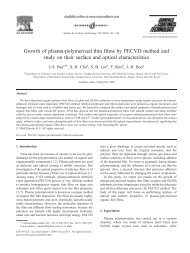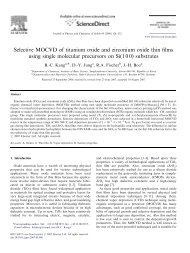Deposition of epitaxial silicon carbide films using high vacuum ...
Deposition of epitaxial silicon carbide films using high vacuum ...
Deposition of epitaxial silicon carbide films using high vacuum ...
You also want an ePaper? Increase the reach of your titles
YUMPU automatically turns print PDFs into web optimized ePapers that Google loves.
8 D.-C. Lim et al. / Thin Solid Films 459 (2004) 7–12<br />
Fig. 1. X-Ray diffraction patterns <strong>of</strong> SiC thin <strong>films</strong> grown on Si(100) substrates <strong>using</strong> DEMD at various deposition temperatures and times given<br />
in the figure.<br />
substrate was mounted on a stainless holder that was<br />
heated by DC power supply. The general CVD condition<br />
y7<br />
y5<br />
was pressures between 2.0=10 Torr and 1.0=10<br />
Torr and growth temperatures <strong>of</strong> 700–1000 8C, respectively.<br />
The substrate temperature was measured with an<br />
optical pyrometer. The deposition time was lasted to be<br />
maximum 6 h and SiC <strong>films</strong> have been grown on both<br />
Si (100) and SiO patterned Si (100) substrates.<br />
2<br />
The diethylmethylsilane (DEMS), (CH CH ) 3 2 2<br />
–SiH–CH , used in this study as single precursor, is a<br />
3<br />
liquid at room temperature with boiling point <strong>of</strong> 78 8C.<br />
This makes the handling aspects much more simplified<br />
compared with conventional dual-source CVD. Also,<br />
the use <strong>of</strong> single precursor insures stoichiometry, hence,<br />
it eliminates the need for an elaborate gas handling<br />
system.<br />
After deposition, a number <strong>of</strong> analysis and characterization<br />
techniques were employed to investigate the<br />
deposited SiC <strong>films</strong>. These include X-ray Photoemission<br />
Spectroscopy (XPS) to confirm chemical composition,<br />
X-ray diffraction (XRD) to determine structural crystallinity,<br />
and Atomic Force Microscope (AFM) to investigate<br />
SiC film topology. Scanning electron microscopy<br />
(SEM) was also used to investigate the SiC film<br />
morphology and the quality <strong>of</strong> the SiCySi interface as<br />
well as to estimate film thickness by cross-sectional<br />
image.<br />
3. Results and discussions<br />
Fig. 1 shows the X-ray u–2u diffraction patterns <strong>of</strong><br />
cubic SiC thin <strong>films</strong> grown on Si (100) surface at<br />
temperatures in the range 700–1000 8C and 1.0=10 y5<br />
Torr for different deposition time. Fig. 1a shows the<br />
XRD pattern <strong>of</strong> SiC thin film grown at 700 8C and 2 h.<br />
From Fig. 1a b, we can see that SiC thin film (1a)<br />
grown at 700 8C and 2 h has an amorphous structure.<br />
However, with increasing the deposition time to 4 h at<br />
the same temperature, the diffraction pattern shown in<br />
the Fig. 1b shows a crystal structure with (200) 3C–<br />
SiC plane (2us41.48) as well as the graphite carbon<br />
structure (2us45.28). This indicates that with single<br />
precursor MOCVD crystalline 3C–SiC film can be<br />
deposited at much lower temperature than conventional<br />
CVD. With increasing the deposition temperatures from<br />
700 to 900 8C, moreover, a significant increase <strong>of</strong> the<br />
intensity <strong>of</strong> 3C–SiC (002) diffraction peaks was<br />
observed, showing an improvement <strong>of</strong> crystallinity. The<br />
XRD pattern (see Fig. 2c) <strong>of</strong> 3C–SiC thin film grown<br />
at 900 8C exhibits a very large and sharp peak at the<br />
(200) reflection <strong>of</strong> 2us41.48. This indicates that this<br />
thin film was grown <strong>epitaxial</strong>ly and may have a monocrystalline<br />
nature with (200) preferred orientation. However,<br />
in the Fig. 1d, small peaks attributed to the 3C–<br />
SiC(111) diffraction also appeared in addition to major


